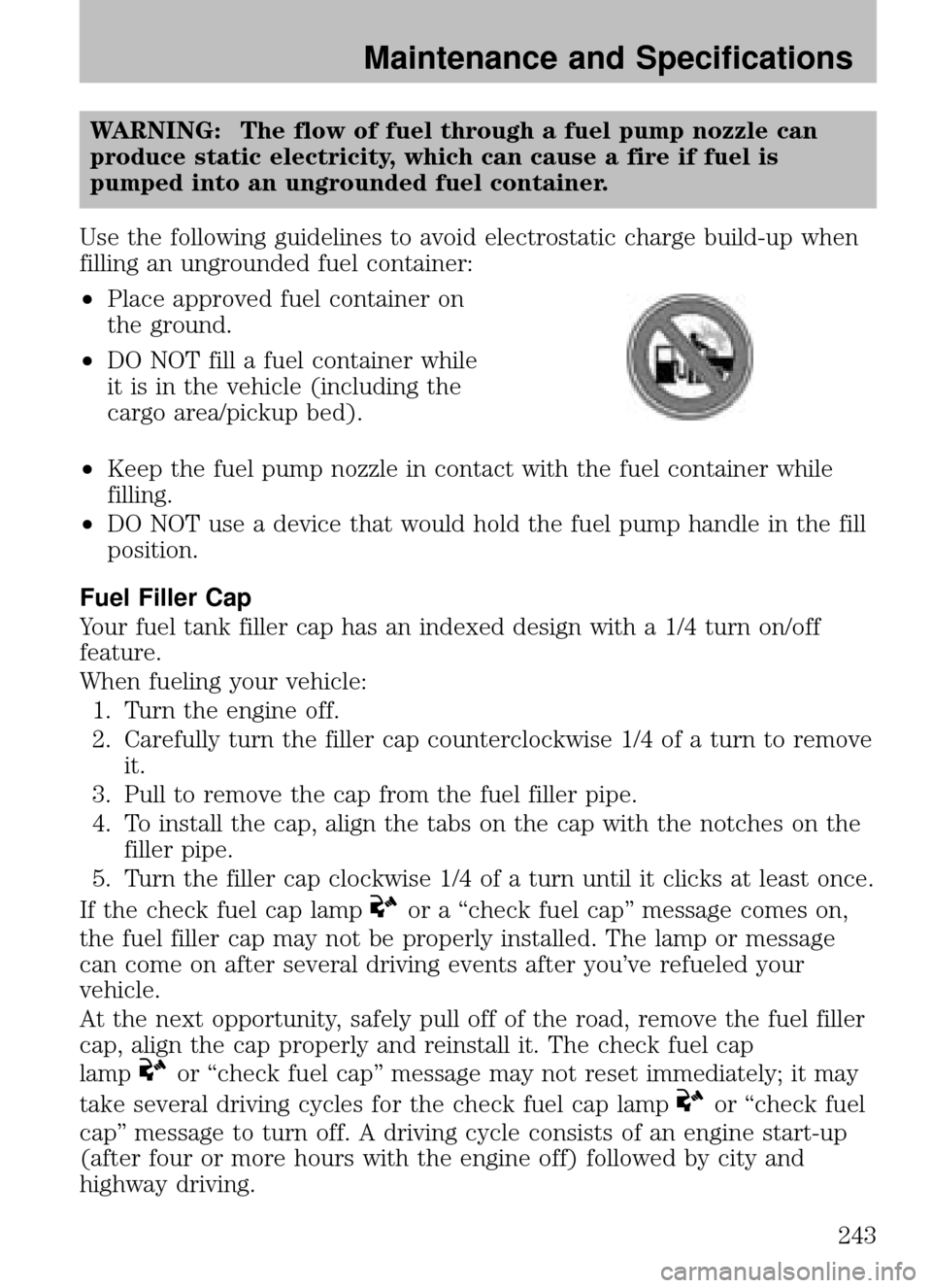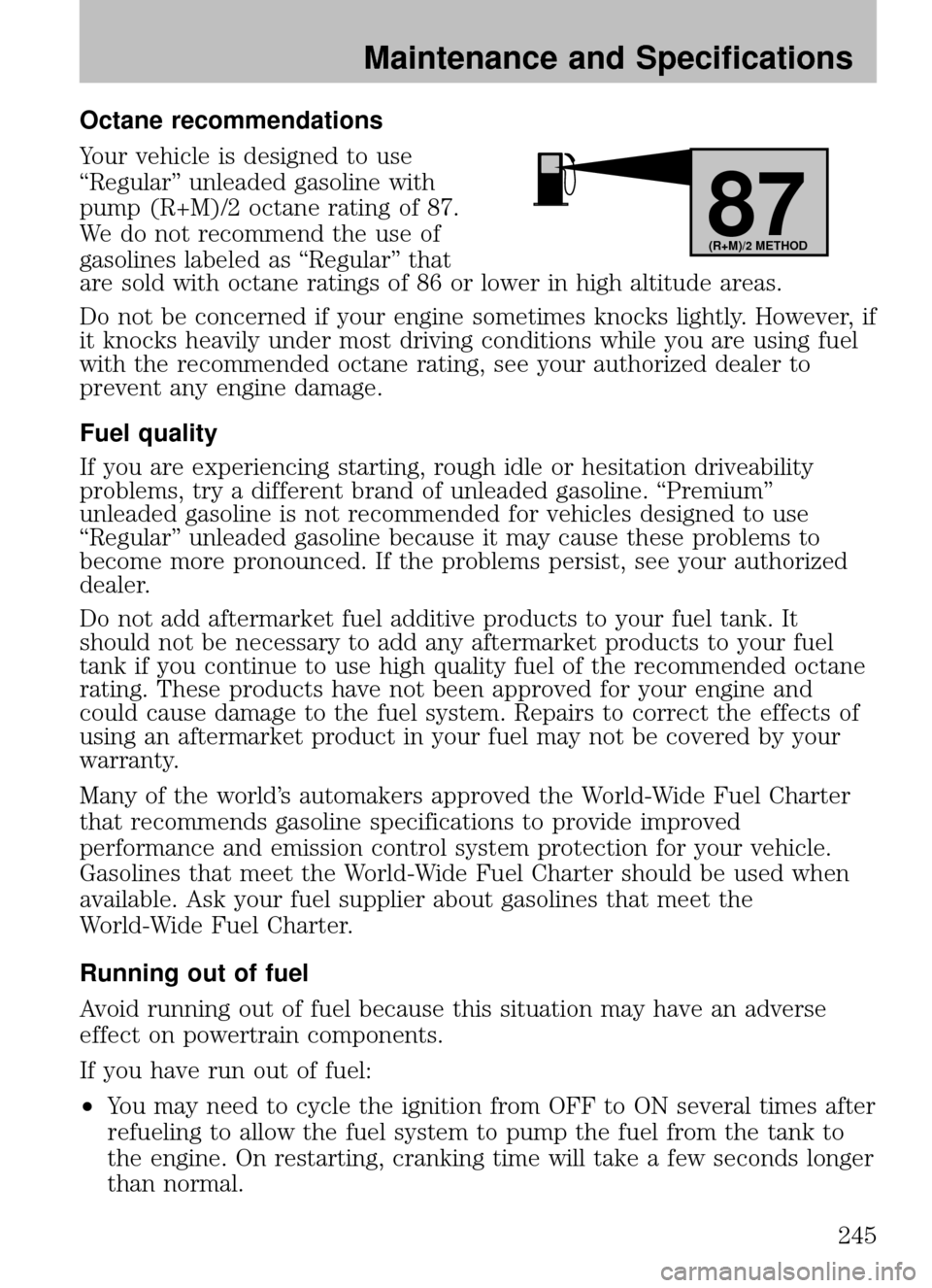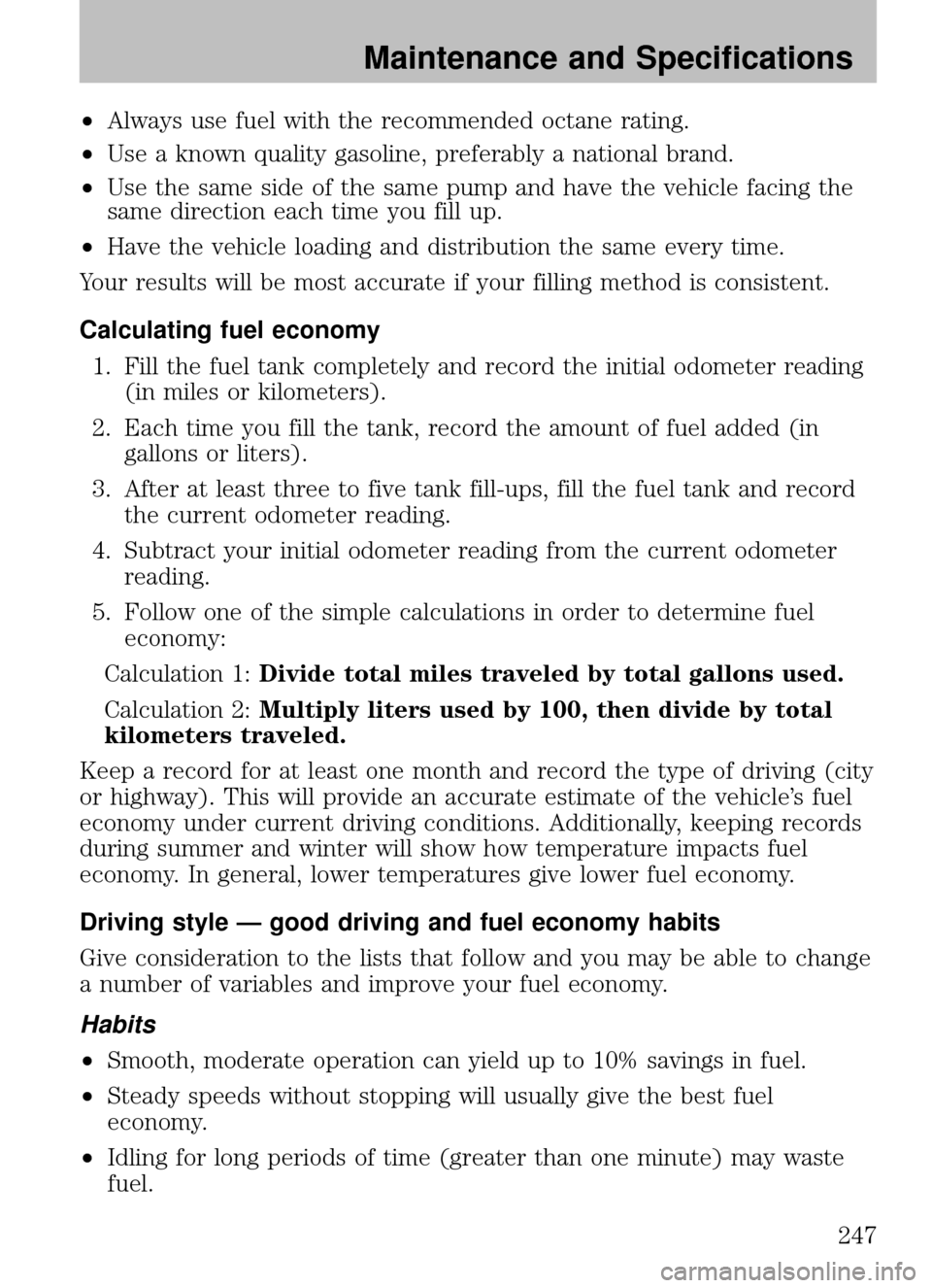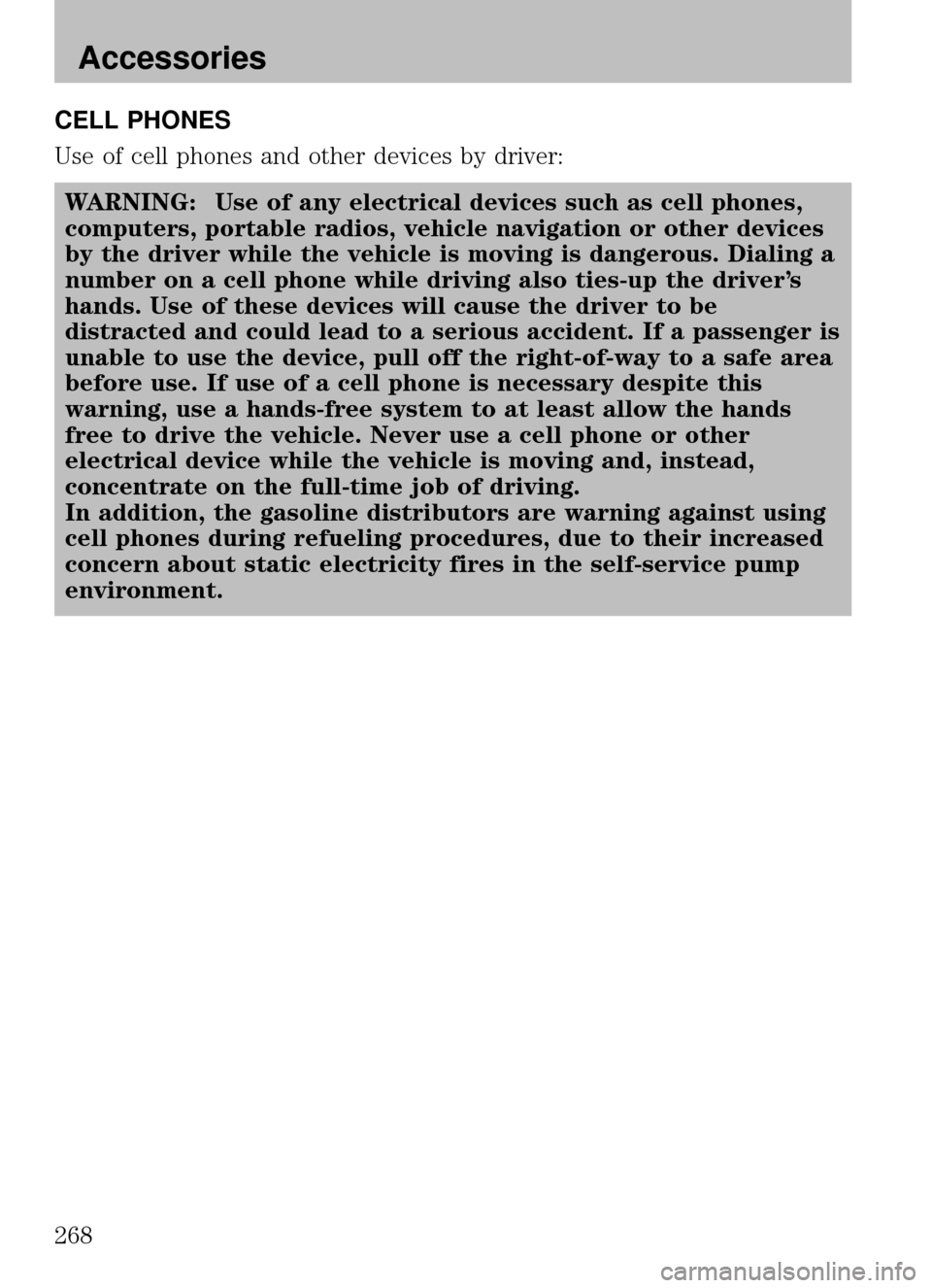2008 MAZDA MODEL B2300 TRUCK fuel pump
[x] Cancel search: fuel pumpPage 178 of 280

Fuse/RelayLocation Fuse Amp
Rating Power Distribution Box Description
15 — Not used
16 — Not used
17 40A** Anti-lock Brake System (ABS) module
18 — Not used
19 — Not used
20 — Not used
21 10A* PCM keep alive power, Canister purge
valve solenoid
22 — Not used
23 30A* Fuel pump motor, Fuel injectors
24 — Not used
25 10A* A/C clutch solenoid
26 — Not used
27 20A* 4x4 module
28 — Not used
29 30A* Wipers/washer
30 — Not used
31 15A* Foglamps
32 — Not used
33 30A* Anti-lock Brake System (ABS) module
34 — Not used
35 — Not used
36 — Not used
37 — Not used
38 7.5A* Trailer tow (right turn)
39 15A* PCM power
40 — Not used
41 10A* Automatic transmission
42 7.5A* Trailer tow (left turn)
43 20A* A/C relay coil, Engine sensors, VMV
solenoid, EGR solenoid, Heated PCV
2008 B-Series (mbs)
Owners Guide (post-2002-fmt)
USA (fus)
Roadside Emergencies
178
Page 179 of 280

Fuse/RelayLocation Fuse Amp
Rating Power Distribution Box Description
44 15A* Ignition coil, Capacitor
45A — Not used
45B — Not used
46A — A/C clutch solenoid
46B — Not used
47 — PCM relay
48A — Fuel pump relay, Fuel injectors relay
48B — Fog lamp relay
51 — Not used
52 — Not used
53 — Not used
54 — Not used
55 — Blower relay
56 — Starter relay
* Mini Fuses ** Maxi Fuses
CHANGING THE TIRES
If you get a flat tire while driving:
• do not brake heavily.
• gradually decrease the vehicle’s speed.
• hold the steering wheel firmly.
• slowly move to a safe place on the side of the road.
Note: The tire pressure monitoring system (TPMS) indicator light will
illuminate when the spare is in use. To restore the full functionality of
the monitoring system, all road wheels equipped with tire pressure
monitoring sensors must be mounted on the vehicle.
Have a flat serviced by an authorized dealer in order to prevent damage
to the TPMS sensor, refer to Changing tires with TPMSin theTires,
Wheels and Loading chapter. Replace the spare tire with a road tire as
soon as possible.
WARNING: The use of tire sealants may damage your Tire
Pressure Monitoring System and should not be used.
2008 B-Series (mbs)
Owners Guide (post-2002-fmt)
USA (fus)
Roadside Emergencies
179
Page 243 of 280

WARNING: The flow of fuel through a fuel pump nozzle can
produce static electricity, which can cause a fire if fuel is
pumped into an ungrounded fuel container.
Use the following guidelines to avoid electrostatic charge build-up when
filling an ungrounded fuel container:
• Place approved fuel container on
the ground.
• DO NOT fill a fuel container while
it is in the vehicle (including the
cargo area/pickup bed).
• Keep the fuel pump nozzle in contact with the fuel container while
filling.
• DO NOT use a device that would hold the fuel pump handle in the fill
position.
Fuel Filler Cap
Your fuel tank filler cap has an indexed design with a 1/4 turn on/off
feature.
When fueling your vehicle: 1. Turn the engine off.
2. Carefully turn the filler cap counterclockwise 1/4 of a turn to remove it.
3. Pull to remove the cap from the fuel filler pipe.
4. To install the cap, align the tabs on the cap with the notches on the filler pipe.
5. Turn the filler cap clockwise 1/4 of a turn until it clicks at least once.
If the check fuel cap lamp
or a “check fuel cap” message comes on,
the fuel filler cap may not be properly installed. The lamp or message
can come on after several driving events after you’ve refueled your
vehicle.
At the next opportunity, safely pull off of the road, remove the fuel filler
cap, align the cap properly and reinstall it. The check fuel cap
lamp
or “check fuel cap” message may not reset immediately; it may
take several driving cycles for the check fuel cap lamp
or “check fuel
cap” message to turn off. A driving cycle consists of an engine start-up
(after four or more hours with the engine off) followed by city and
highway driving.
2008 B-Series (mbs)
Owners Guide (post-2002-fmt)
USA (fus)
Maintenance and Specifications
243
Page 245 of 280

Octane recommendations
Your vehicle is designed to use
“Regular” unleaded gasoline with
pump (R+M)/2 octane rating of 87.
We do not recommend the use of
gasolines labeled as “Regular” that
are sold with octane ratings of 86 or lower in high altitude areas.
Do not be concerned if your engine sometimes knocks lightly. However, if
it knocks heavily under most driving conditions while you are using fuel
with the recommended octane rating, see your authorized dealer to
prevent any engine damage.
Fuel quality
If you are experiencing starting, rough idle or hesitation driveability
problems, try a different brand of unleaded gasoline. “Premium”
unleaded gasoline is not recommended for vehicles designed to use
“Regular” unleaded gasoline because it may cause these problems to
become more pronounced. If the problems persist, see your authorized
dealer.
Do not add aftermarket fuel additive products to your fuel tank. It
should not be necessary to add any aftermarket products to your fuel
tank if you continue to use high quality fuel of the recommended octane
rating. These products have not been approved for your engine and
could cause damage to the fuel system. Repairs to correct the effects of
using an aftermarket product in your fuel may not be covered by your
warranty.
Many of the world’s automakers approved the World-Wide Fuel Charter
that recommends gasoline specifications to provide improved
performance and emission control system protection for your vehicle.
Gasolines that meet the World-Wide Fuel Charter should be used when
available. Ask your fuel supplier about gasolines that meet the
World-Wide Fuel Charter.
Running out of fuel
Avoid running out of fuel because this situation may have an adverse
effect on powertrain components.
If you have run out of fuel:
•You may need to cycle the ignition from OFF to ON several times after
refueling to allow the fuel system to pump the fuel from the tank to
the engine. On restarting, cranking time will take a few seconds longer
than normal.
87(R+M)/2 METHOD
2008 B-Series (mbs)
Owners Guide (post-2002-fmt)
USA (fus)
Maintenance and Specifications
245
Page 247 of 280

•Always use fuel with the recommended octane rating.
• Use a known quality gasoline, preferably a national brand.
• Use the same side of the same pump and have the vehicle facing the
same direction each time you fill up.
• Have the vehicle loading and distribution the same every time.
Your results will be most accurate if your filling method is consistent.
Calculating fuel economy 1. Fill the fuel tank completely and record the initial odometer reading (in miles or kilometers).
2. Each time you fill the tank, record the amount of fuel added (in gallons or liters).
3. After at least three to five tank fill-ups, fill the fuel tank and record the current odometer reading.
4. Subtract your initial odometer reading from the current odometer reading.
5. Follow one of the simple calculations in order to determine fuel economy:
Calculation 1: Divide total miles traveled by total gallons used.
Calculation 2: Multiply liters used by 100, then divide by total
kilometers traveled.
Keep a record for at least one month and record the type of driving (city
or highway). This will provide an accurate estimate of the vehicle’s fuel
economy under current driving conditions. Additionally, keeping records
during summer and winter will show how temperature impacts fuel
economy. In general, lower temperatures give lower fuel economy.
Driving style — good driving and fuel economy habits
Give consideration to the lists that follow and you may be able to change
a number of variables and improve your fuel economy.
Habits
• Smooth, moderate operation can yield up to 10% savings in fuel.
• Steady speeds without stopping will usually give the best fuel
economy.
• Idling for long periods of time (greater than one minute) may waste
fuel.
2008 B-Series (mbs)
Owners Guide (post-2002-fmt)
USA (fus)
Maintenance and Specifications
247
Page 268 of 280

CELL PHONES
Use of cell phones and other devices by driver:WARNING: Use of any electrical devices such as cell phones,
computers, portable radios, vehicle navigation or other devices
by the driver while the vehicle is moving is dangerous. Dialing a
number on a cell phone while driving also ties-up the driver’s
hands. Use of these devices will cause the driver to be
distracted and could lead to a serious accident. If a passenger is
unable to use the device, pull off the right-of-way to a safe area
before use. If use of a cell phone is necessary despite this
warning, use a hands-free system to at least allow the hands
free to drive the vehicle. Never use a cell phone or other
electrical device while the vehicle is moving and, instead,
concentrate on the full-time job of driving.
In addition, the gasoline distributors are warning against using
cell phones during refueling procedures, due to their increased
concern about static electricity fires in the self-service pump
environment.
2008 B-Series (mbs)
Owners Guide (post-2002-fmt)
USA (fus)
Accessories
268
Page 270 of 280

wiper blades ............................210
Clock adjust AM/FM Stereo ...........................20
AM/FM stereo CD .....................21
Premium AM/FM stereo
CD6/MP3 ...................................27
Clutch fluid ..........................................254
operation while driving ..........159
recommended shift speeds ....160
Console ........................................54
Coolant checking and adding ..............235
refill capacities ........................240
specifications ..........................260
Cruise control
(see Speed control) ....................57
Customer
Assistance ..................196–197, 199
D
Daytime running lamps
(see Lamps) ................................43
Dipstick engine oil .................................227
Driveline universal joint and
slip yoke ....................................258
Driving under special
conditions ..................161, 164, 166 mud ..........................................165
sand .........................................165
snow and ice ...........................167
through water .................165, 167
E
Emergencies, roadside jump-starting ..........................189 Emergency Flashers .................168
Emission control system ..........249
Engine ........................................264
cleaning ...................................208
coolant .....................................235
idle speed control ...................233
lubrication specifications .......260
service points ..................223–225
starting after a collision .........168
Engine block heater .................150
Engine oil ..................................227 checking and adding ..............227
dipstick ....................................227
filter, specifications ................231
recommendations ...................231
specifications ..........................260
Event data recording ....................6
Exhaust fumes ..........................149
F
Foglamps .....................................42
Four-Wheel Drive vehicles .......161 driving off road .......................163
electronic shift ........................162
indicator light .........................162
preparing to drive your
vehicle .....................................155
Fuel ............................................241 calculating fuel economy .......246
cap ...........................................243
choosing the right fuel ...........244
comparisons with EPA fuel
economy estimates .................249
detergent in fuel .....................244
filling your vehicle
with fuel ..................241, 243, 246
filter, specifications ................241
fuel pump shut-off switch .....168
improving fuel economy ........246
2008 B-Series (mbs)
Owners Guide (post-2002-fmt)
USA (fus)
Index
270
Page 271 of 280

octane rating ...................245, 264
quality ......................................245
running out of fuel .................245
safety information relating to
automotive fuels .....................241
Fuel pump shut-off switch .......168
Fuses ..................................169–170
G
Gas cap (see Fuel cap) ............243
Gas mileage
(see Fuel economy) .................246
Gauges .........................................17
H
Hazard flashers .........................168
Headlamps ...................................42 aiming ........................................44
bulb specifications ....................46
daytime running lights .............43
flash to pass ..............................43
high beam .................................42
replacing bulbs .........................47
turning on and off ....................42
Heating heating and air conditioning
system .................................39–40
Hood ..........................................222
I
Ignition ...............................146, 264
Infant seats (see Safety seats) ..99
Inspection/maintenance (I/M)
testing ........................................251
Instrument panel cleaning ...................................211 cluster ........................................12
lighting up panel and
interior .......................................43
location of components ............12
J
Jack ............................................179 positioning ...............................179
storage .............................179, 182
Jump-starting your vehicle ......189
K
Keys .......................................62, 67 positions of the ignition .........146
L
Lamps bulb replacement
specifications chart ..................46
daytime running light ...............43
fog lamps ...................................42
headlamps .................................42
headlamps, flash to pass ..........43
instrument panel, dimming .....43
interior lamps .....................46–47
replacing bulbs .........................47
Lane change indicator
(see Turn signal) ........................46
Lights, warning and indicator ....12 anti-lock brakes (ABS) ..........153
Load limits .................................129
Loading instructions .................135
Locks doors ..........................................62
Lubricant specifications ...........260
Lug nuts ....................................187
M
Manual transmission .................159
2008 B-Series (mbs)
Owners Guide (post-2002-fmt)
USA (fus)
Index
271